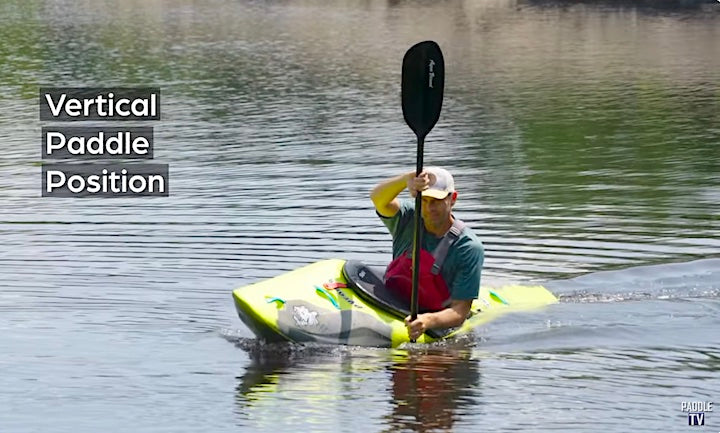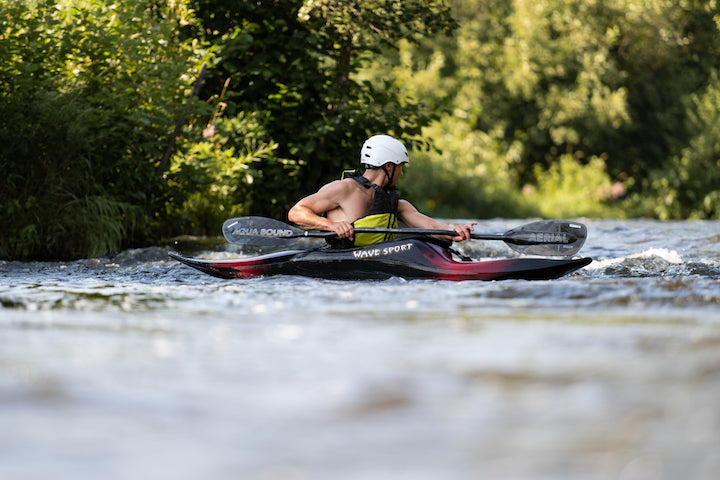3 Whitewater Kayaking Skills You Need to Master
4-minute read + 15-minute video
Aqua Bound Ambassador and whitewater expert Ken Whiting shows us three kayaking skills every whitewater paddler must master.

(photo courtesy of Casey Bryant Jones)
In the video below, Ken takes us through three important whitewater skills. The best way to master them is to practice them over and over on calm flatwater until they become second nature.
Get these down and you’ll improve your whitewater game exponentially!
Watch Ken’s video below:
1. Carving
Carving refers to running on the edge of your kayak as you turn. “Carving is how you make solid, efficient eddy turns and good ferries. But also, it unlocks the door to all sorts of other cool moves including surfing waves and play moves,” says Ken.
To practice carving, get some momentum going then lean into your turn while you use a forward stroke on the inside of the circle you’re moving in. Keep leaning in so you’re kayak is on its inside edge.
You’ll use your inside hip/rear and knee to fine-tune your kayak’s tilt as you move. You’re able to keep paddling forward on just the inside of the arc because you’re using the edge of the boat.
As you do this it’s vital to keep your paddle vertical with each stroke. If you straighten out your stroke to be more horizontal, you’ll lose your turning momentum. When carving, your paddle provides movement only, not bracing or support for your balance. That support is coming from your contact points inside your kayak.

Practice carving in both directions with that vertical paddle stroke until you’re confident with it. Then you’re ready for the next step, which is to apply more power to each stroke.
You’ll still keep leaning in and keep your paddle vertical. Now thrust your core forward with each stroke to add power, all while keeping your kayak on its edge. This is known as a boof stroke, which whitewater paddlers use when going over waterfalls, in eddy turns and many other applications.
2. Pivot Turns
Learn and practice pivot turns on flatwater using a slice or half-slice whitewater kayak.
[A slice whitewater kayak has a low-volume bow and stern. They’re designed for skilled whitewater paddlers as playboats. Half-slice kayaks have a low-volume, flatter stern but a full-volume bow. Half-slice boats are more versatile and easier to stay upright in for paddlers who are still refining their skills.]

A slice whitewater kayak has a low-profile stern and bow (photo courtesy of Kate Wright)
A pivot turn means you sink your kayak’s stern in the water as you turn so you can turn more quickly. This is really important to learn because it teaches you to control your kayak’s momentum as it spins.
Another reason the pivot turn is a must-have skill is to “harness the power of buoyancy energy,” as Ken says. When your kayak’s stern is underwater it wants to get back to the surface. Learning a good pivot turn uses that buoyancy energy to your advantage.
It’s important to learn how to gradually level out your edge as you pivot turn so your kayak will complete its full turn, moving in the direction you want it to go.
Practice pivot turns on both sides with a forward sweep stroke and also a back sweep. Flatwater is an ideal environment to practice in. You’ll know immediately if you’re not leveling out soon enough as you won’t be able to complete your circle if you’re still on your kayak’s edge.
3. Backpaddling
Backpaddling is the third key skill you need to be comfortable with as a whitewater kayaker.
One of its main benefits is to increase your “backward awareness” and your ability to deal with being turned around in the middle of a rapid. Having equal awareness backward and forwards means you don’t have to panic in those situations.
So spend time backward. Use a backstroke to get comfortable moving backward and practice, practice, practice. As you backpaddle keep your weight slightly forward (especially in a slicey kayak) and tilt your weight slightly side to side with each stroke. This will help you keep your stern edges out of the water as you move.
Ken tells a story when he and a buddy spent an entire month kayaking the Ottawa River backward one summer. “Yes, we got beaten up a few times! But the improvement we saw after that month was truly remarkable. I’d never seen my paddling take a jump like that,” says Ken.

Kayaker using a pivot turn in whitewater (photo courtesy of Kate Wright)
Once you’ve got some flatwater experience in your whitewater kayak, practice everything backward, starting with simple eddies and ferries. Even warm up by backpaddling. With enough practice you’ll be able to take on rapids and even waves backward.
Backpaddling also works different upper body muscles than paddling forward, so you have a chance to balance out your muscle use.
Master those three skills on flatwater and you’ll be amazed at how they’ll add to your whitewater paddling ability and fun!
Do you have paddle questions our friendly Customer Service Team can help you with today? Contact them: 715-755-3405 • sales@aquabound.com
More for you...





